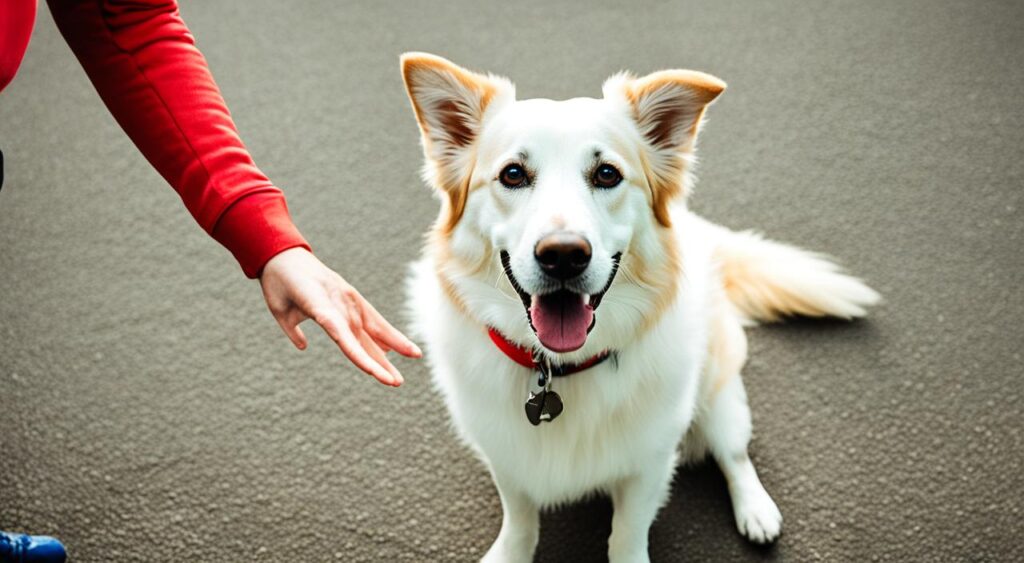Teaching your dog to sit and lie down may seem challenging, but it is a fundamental skill to ensure your pet’s obedience and discipline. Fortunately, there are quick and effective techniques for teaching your dog these commands. This article will provide practical tips and useful guidance to facilitate the training process.
Key Takeaways:
- Teaching your dog to sit and lie down is important to ensure his discipline and obedience.
- There are quick and effective techniques for teaching these commands.
- Patience and consistency are key to the training process.
- Positive reinforcement is an effective way to encourage your dog during training.
- Combining sit and lie down commands is a way to make training more advanced.
Importance of Teaching Your Dog to Sit and Lie Down
Teaching your dog to sit and lie down is essential in promoting good behavior and obedience. These simple commands form the foundation of any training regimen and help to establish a strong relationship between you and your furry companion. A well-trained dog is not only easier to manage but also more confident and content.
The training process for these commands is relatively straightforward, as discussed in the previous section. Once your dog learns to sit and lie down on command, you can effectively communicate and establish boundaries with your pet. For example, you can use the “sit” or “lie down” command to prevent your dog from jumping on guests or running off.
Consistent training is key to ensuring that your dog understands and obeys these commands. It is also essential to reward your dog’s good behavior with treats or positive reinforcement. With patience and perseverance, your dog will quickly master these commands, making both your lives more comfortable and enjoyable.
Benefits of Teaching Your Dog to Sit and Lie Down
Teaching your dog to sit and lie down brings about numerous benefits, including:
- Better behavior: These commands promote good behavior and discourage negative actions such as jumping or running away.
- Improved obedience: A well-trained dog is more obedient and easier to manage, resulting in a more pleasant atmosphere at home.
- Stronger bond: The training process strengthens the emotional connection between you and your dog, promoting a positive and healthy relationship.
- Improved safety: By obeying these commands, your dog will be less likely to wander into the street or engage in other dangerous behaviors.
In conclusion, teaching your dog to sit and lie down is crucial in promoting good behavior, obedience, and safety. The training process is simple and easily achievable with consistency and positive reinforcement. By doing so, you’ll not only have a happier and more content pet but also a closer and more fulfilling relationship with your furry companion.
Step-by-Step Guide to Teach Your Dog to Sit
Teaching your dog to sit is an essential command that can be easily taught by following simple steps and techniques. Below, you’ll find a detailed step-by-step guide to help you teach your furry friend how to sit.
- Start with basic commands: Before teaching your dog to sit, it’s essential to establish basic commands such as “come” and “stay.” This baseline will help your dog to better understand and respond to new commands, including “sit.”
- Use treats as rewards: Dogs are more likely to learn a behavior when they receive positive reinforcement. Consider using small treats as a reward for successfully performing the “sit” command.
- Position your dog: Start by standing in front of your dog with a treat in your hand. Hold the treat in front of their nose and let them sniff it to get their attention.
- Raise the treat: Slowly raise the treat above their head while moving it towards the back of their body. As the dog follows the treat with their head, they will naturally sit down to maintain eye contact with the treat.
- Verbal command: Once your dog sits, use a verbal command, such as “sit” or “good sit,” and reward them with the treat.
- Practice: Repeating these steps will help your dog to understand what you expect when you use the verbal command “sit.” Practice this several times a day for best results.
Remember to keep these sessions brief and positive. Always reward your dog for their progress, and never punish them if they don’t quite get it right. Consistency and patience will help your furry friend to learn and master the “sit” command in no time.
Common Challenges and Solutions in Teaching Sit Command
Teaching your dog to sit is a crucial command that requires patience, consistency, and determination. However, several common challenges may arise throughout the training process that could hinder progress. In this section, we will explore some of the most typical obstacles faced during sit command training and provide effective tips and solutions on how to overcome them.
1. Lack of Consistency
One of the most common reasons for a dog’s failure to learn the “sit” command is a lack of consistency. All family members or anyone who interacts with your dog should be aware of and use the same verbal cue and hand signal during training sessions. Be sure to praise and reward your dog for sitting in response to the command, thus reinforcing proper behavior.
2. Distractions
Another frequent obstacle in sit command training is distractions. Dogs may find it challenging to stay focused when outside or in a new environment with unfamiliar objects and people. To address this issue, start training in a quiet, secluded area. Gradually increase the distraction level as your dog becomes more confident in obeying the command.
3. Fear and Anxiety
Some dogs may develop fear or anxiety during training sessions, making it challenging to teach them the “sit” command. If this occurs, provide reassurance and encourage your dog positively. Try using treats and reward-based training techniques to build trust and increase your pet’s confidence level.
4. Improper Timing
Timing is crucial in teaching the “sit” command. If you issue the command too late or early, your dog may not understand the desired behavior. Ensure that your dog knows the hand signal and the verbal cue before attempting to train him in a distracting environment.
5. Health Issues
Sometimes, dogs may have underlying health issues that prove problematic for successful training. Joint pain, hearing loss, or other physical ailments may prevent your dog from understanding and obeying commands fully. Consult your veterinarian if you suspect that your dog’s health is impacting his training.
In conclusion, teaching your dog to sit has many benefits and is an essential part of his obedience training. However, it may present challenges, making it difficult to obtain the desired results. By following our expert tips and solutions, you can overcome these obstacles and build a strong, trusting relationship with your furry friend.

Reinforcing the Lie Down Command
Now that your pooch has mastered the “lie down” command, it’s time to reinforce this essential behavior. Consistency is key to ensuring long-term success, and incorporating additional exercises into your dog’s training regimen can help solidify their understanding of the behavior.
One technique to reinforce “lie down” is to gradually increase the duration of the behavior. Once your dog has learned to lie down on command, try expanding the length of time they remain in position. Start with a few seconds and gradually work your way up to several minutes. Always reward your furry friend for staying in position, and avoid punishing them if they get up early.
An alternative method is to introduce distractions during training. Have someone walk by or make a noise to see if your dog stays in position. Initially, keep the distractions minimal, and gradually increase them over time.
It’s also important to provide regular reinforcement to prevent your dog from regressing. Praise them when they respond correctly to the command, and use treats or toys as positive reinforcements. Gradually reduce the frequency of treats, but continue to provide verbal praise and affection for good behavior.
In summary, reinforcing the “lie down” command requires consistency, patience, and the use of multiple reinforcement techniques. By incorporating these exercises into your dog’s training regimen, you can help ensure long-term success.
Troubleshooting When Teaching Lie Down Command
It’s not uncommon for pet owners to encounter obstacles when training their dogs to lie down. Fortunately, there are practical solutions and strategies for overcoming these challenges.
Challenge #1: Dog Refuses to Lie Down
If your dog is resisting the “lie down” command, there may be several reasons. One common issue is lack of motivation or reward. Make sure to reinforce positive behavior with treats and praise. Also, check that your dog is not in a distracting environment and is comfortable with the command.
“The best way to motivate a dog to lie down is by offering a reward that they cherish,” says Dr. Jessica Lee, a veterinarian and dog behavior specialist. “For instance, they might appreciate a special type of treat or a favorite toy. Always reward them with something they truly value.”
Challenge #2: Dog gets up too quickly
If your dog is not staying in the lying position long enough, it may indicate that they haven’t completely understood the command. Try using a leash to keep them in place, and gradually increase the time they must remain lying down.
“Aim to increase the challenge with patience and consistency,” advises Karen Schneider, a professional dog trainer. “Teach your dog to stay longer in the command incrementally, and continue to reward positive behavior.”
Challenge #3: Dog Lies Down, but Only Partially
If your dog is performing an incomplete lie-down and only lowers their front legs, you should re-evaluate your technique. Make sure that you use a clear and concise verbal command, and use your hand gestures to guide them into the proper position. Consistently praise and reward them when they perform the correct behavior.
Final Thoughts
Training your dog to lie down can be challenging, but it’s important to stick with it until the desired behavior is achieved. By using positive reinforcement and consistently practicing the command, you can help your furry friend master the skill of lying down.
Combining Sit and Lie Down Commands
Teaching your dog to sit and lie down are two essential commands in obedience training. Once your furry friend has mastered these behaviors, it is time to combine them and create a seamless transition between the two commands.
To combine the “sit” and “lie down” commands, follow these steps:
- Start by asking your dog to “sit”
- Once your dog is sitting, show him a treat and slowly lower it to the ground
- As your dog follows the treat, he will naturally move into a lying down position
- As soon as your dog is lying down, say “lie down” and reward him with the treat
- Repeat this exercise until your dog transitions smoothly from the “sit” command to the “lie down” command
Consistency is key when combining these commands. Practice regularly and use positive reinforcement techniques such as treats and praise to encourage your dog’s progress.

With time and patience, your dog will master the transition between the “sit” and “lie down” commands, and you will both enjoy a more rewarding training experience.
Advanced Techniques for Sit and Lie Down Training
In order to elevate your dog’s sitting and lying down skills to the next level, it’s essential to incorporate advanced techniques into their training routine. These methods are designed to challenge and stimulate your furry friend, making the learning process more engaging and effective.
Targeting
A great technique to enhance your dog’s accuracy and speed in performing commands is targeting. This involves teaching your dog to touch a specific object with their nose or paw, such as a target stick or your hand.
To begin, hold the target in front of your dog and wait for them to touch it with their nose or paw. Immediately after they touch it, reward them with a treat. Repeat this process multiple times until your dog becomes comfortable with touching the target.
Next, add a verbal cue, such as “touch,” and introduce different angles and positions for the target. Gradually increase the difficulty level by adding distractions or increasing the distance between your dog and the target. Targeting can be used to reinforce both the sitting and lying down commands.
Shaping
Shaping is another advanced technique that can be used for sit and lie down training. This involves reinforcing gradual approximations of the desired behavior, rather than rewarding only the final outcome.
To use shaping for the sit command, start by rewarding your dog for any slight movement towards a sitting position, such as bending their legs. Gradually increase the criteria for the reward until your dog performs a full sit. Repeat this process until your dog can sit on command without any assistance.
For the lie down command, shape your dog’s behavior by rewarding any movement towards a lying down position, such as lowering their head. Increase the criteria for the reward until your dog performs a full lie down. Shaping takes time and patience, but it can be a highly effective method for advanced training.
Combination Commands
Once your dog has mastery of the sit and lie down commands, it’s time to introduce combination commands. This involves assigning specific cues for your dog to perform multiple commands in a sequence.
For example, you can train your dog to sit and then immediately lie down by using the cue “sit” followed by the cue “down.” Practice this sequence until your dog can perform both commands smoothly and accurately.
Remember to use verbal praise and treats to reinforce good behavior, and to stay patient and consistent throughout the advanced training process!
Consistency and Patience in Dog Training
While training your dog to sit and lie down, consistency and patience are key factors. Dogs are creatures of habit, and by repeating the same commands and techniques regularly, you can reinforce the desired behavior in their minds.
It’s also crucial to remain patient during the training process. Dogs may take longer to learn than others, but it doesn’t mean they won’t eventually get it. Yelling or punishing your dog for not following commands will only cause fear and confusion, which will negatively affect their learning experience.
It’s essential to maintain a positive training environment by using treats, praise, and affection to reward your dog’s good behavior. Remember to take short breaks to prevent your dog from getting bored or overwhelmed.
By incorporating consistency and patience into your dog’s training, you can help them learn faster and develop a lifelong obedience habit.
Conclusion
Teaching your dog to sit and lie down is an essential part of obedience training. By following the step-by-step guide and expert tips provided in this article, you can make the training process easier and more successful.
Remember to be consistent and patient with your furry friend. Practice and positive reinforcement are key to achieving the desired results. With time and effort, your dog will learn to sit and lie down on command.
By mastering the commands of sentar e deitar, you can enjoy a more obedient and well-behaved dog. So, start training today and enjoy an even closer bond with your four-legged companion!
FAQ
What is the best method to teach my dog to sit and lie down?
The most effective method is positive reinforcement. By using treats or verbal praise, you can reward your dog when they correctly perform the desired behavior. Consistency and patience are crucial for successful training.
How long does it take to teach a dog to sit and lie down?
The time it takes to teach your dog to sit and lie down can vary depending on their age, breed, and individual temperament. However, with dedicated training sessions and consistency, you can typically achieve results within a few weeks.
Can I teach my older dog to sit and lie down?
Absolutely! Dogs of any age can learn new commands. It may take a bit more time and patience with older dogs, but with consistent training and positive reinforcement, they can successfully learn to sit and lie down.
What are the benefits of teaching my dog to sit and lie down?
Teaching your dog to sit and lie down is essential for their obedience and discipline. These commands help establish boundaries, promote good behavior, and ensure your dog’s safety in various situations.
How do I troubleshoot if my dog is not learning to sit or lie down?
If your dog is struggling to learn these commands, it may be helpful to reassess your training techniques. Ensure that you are using positive reinforcement, breaking down the training process into manageable steps, and providing ample practice opportunities. If difficulties persist, consult a professional dog trainer for guidance.
Can I combine the sit and lie down commands?
Yes, it is possible to combine these commands once your dog has mastered each behavior individually. Gradually transition between the two commands during training sessions and reinforce with rewards. This flexibility will enhance your dog’s obedience and understanding.
Are there any advanced techniques for sit and lie down training?
Once your dog has mastered the basic commands, you can introduce advanced techniques such as hand signals or verbal cues without using treats. These techniques further reinforce your dog’s understanding and responsiveness.
How important is consistency and patience in dog training?
Consistency and patience are crucial in dog training. Maintain a regular training schedule, use the same verbal cues and gestures, and consistently reward the desired behavior. Patience is vital as dogs may progress at different rates, and training requires repetition and practice.
Can I train my dog to sit and lie down without professional help?
Yes, you can train your dog to sit and lie down without professional help. With the proper knowledge, techniques, and consistent practice, you can successfully teach these commands to your furry companion. However, consulting a professional trainer can provide additional guidance and support if needed.
What should I do if my dog refuses to sit or lie down?
If your dog refuses to sit or lie down during training, assess the training environment for any distractions or obstacles. Ensure that you are using positive reinforcement effectively and consider breaking down the command into smaller, more manageable steps. If issues persist, seek guidance from a professional dog trainer.




